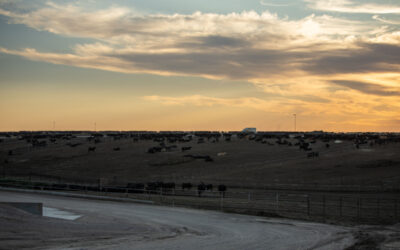
Health, Vaccinations Not Synonymous
by Laura Conaway
Victory in war starts long before the battle. The same is true in combat against cattle diseases.
“My job as a military commander is to take a soldier and make him resilient,” Col. Sam Barringer said at the Feeding Quality Forum in Sioux City, Iowa this summer. The veterinarian and technical specialist for Diamond V illustrated the point by stretching a rubber band: too much pressure, no matter the reason, may cause it to break.
Calves arriving at a feedyard are naturally deployed with a degree of stress, Barringer said. Vaccinating at that time stretches their rubber band of immunity. If the targeted disease shows up, the vaccine may help; if not, that band still stretches.
“We’ve got this idea that if you vaccinate, that equates to health,” he said. “That is not the case. Health and vaccinations are not synonymous.”
Cattle encounter “bugs” representing hundreds of different diseases over time. On average, the industry vaccinates calves for nine of them—and even then, it doesn’t mean they won’t get sick.

Barringer returned to the comparison of training soldiers: “There are things they’re going to see that I could have never predicted.” Cattlemen must anticipate the same unknown challenges, so the band can stretch but not snap.
The ability to handle whatever may come determines survival and performance in the yard. However, the cattle industry can’t function well by assuming the next person in the supply chain will make up for what’s lacking. Proactive measures need to start at the cow-calf level and continue with communication down the line.
“We pick genetics and we try to get the absolute best gains and carcass characteristics, but how many of you thought about picking cattle that can bounce back after stress?” Barringer asked.
Beyond genetics and vaccines, he urged a higher view, beyond routine.
“What can we do to cattle to give them broad-based resiliency? No matter how good the genetic makeup of a calf, a sick one will lose money every time,” he said.
Routine responses get in the way of progress, Barringer said, citing examples where “we think we’re doing the right thing and it’s wrong – we just don’t know because it’s become normalized – ask why you do what you do.
“Make sure you understand it and the people around you understand, it because it can be dang hard to achieve excellence if you don’t know why you’re doing something,” he said.

Trying to protect against every known cattle pathogen today could mean 32 vaccines.
“What do you think 32 vaccines would do to your cattle on arrival at a feedyard?” he asked. “Every vaccine we give takes energy out of the system,” so the solution must include other protection.
“The immune system is designed to detect very, very small differences that your human eye can’t pick up. But we’re not initiating that immune system,” he said. “In large part, we’re not implementing what it can do.”
Citing data that supports a nutrient additive approach to decreased illness on feed, Barringer said, “ruminant resiliency is huge.” Returning to the soldier comparison, he added, “I build guys that can go out there and not fall apart on me.”
The forum was presented by Certified Angus Beef ® (CAB®) with cosponsors Where Food Comes From, Roto-Mix, Feedlot Magazine, Tyson Foods, Intellibond, Zoetis and Diamond V.
you may also like
Feeding Quality Forum Dates Set Earlier in August
When you’re feeding cattle, it counts to keep track of every calf, pound and dollar. Beyond the event’s educational sessions, networking between segments of the beef supply chain is invaluable—from feeders and cow-calf operators to allied industry and university researchers.
Every Issue Has Its Moment
Progress happens when people are at the table, engaged and committed to action. With a vested interest in the industry’s future, CAB is leaning in on conversations surrounding evolutions in meat science.
Feeding Better Cattle Better
Not everyone is cut out to be a cattle feeder. It’s an art and a science that comes with a need to overcome risk. Wayne Carpenter fed his first pen of steers in 1980 and lost money. But he stuck with it. Today with their sons’ families, he and wife Leisha run the 15,000-head-capacity Carpenter Cattle Company.



